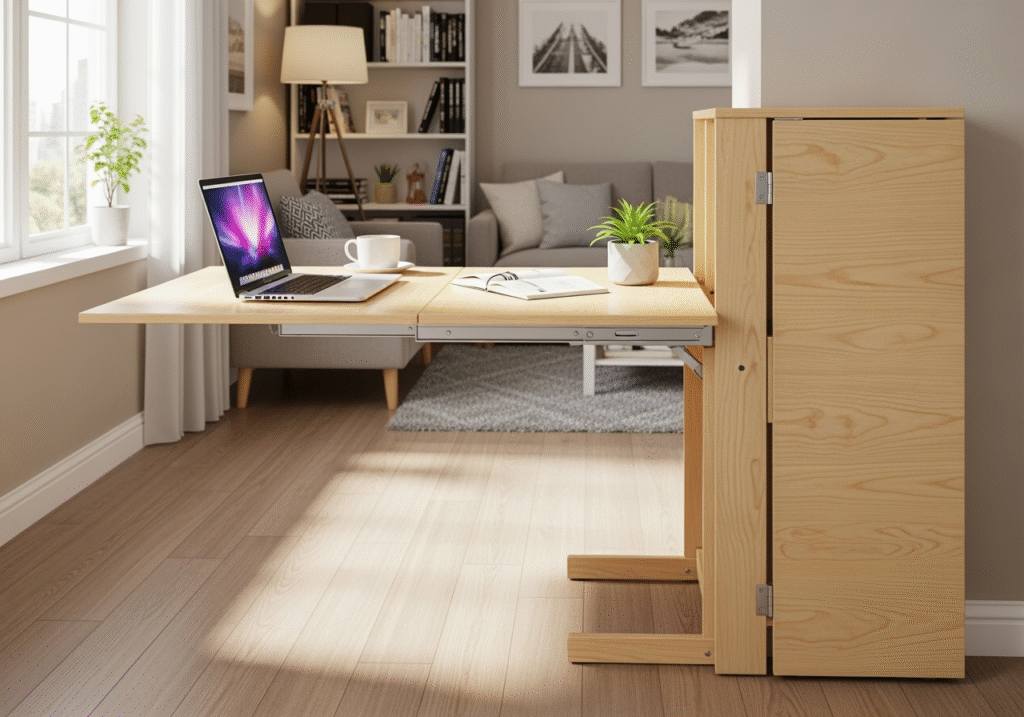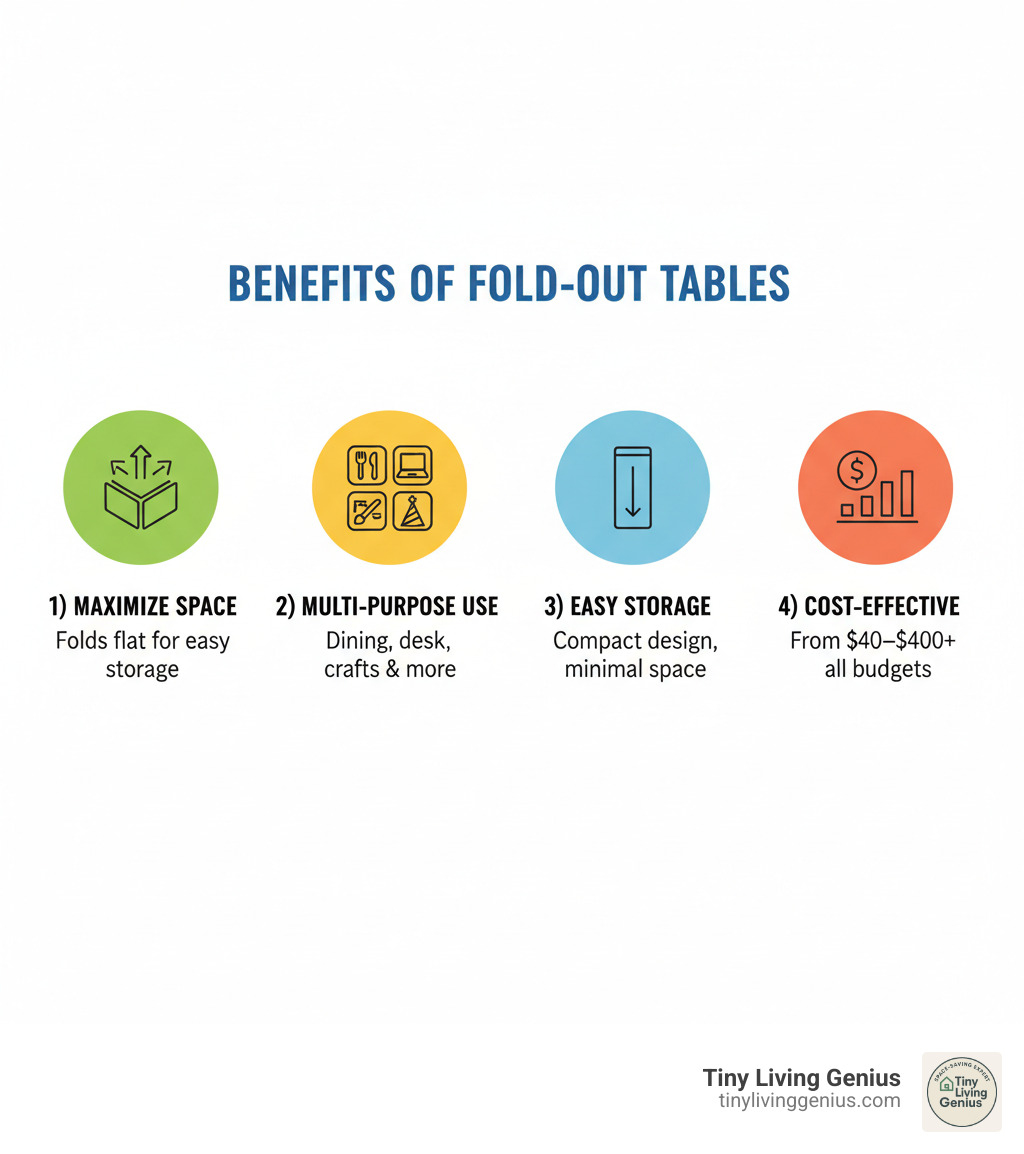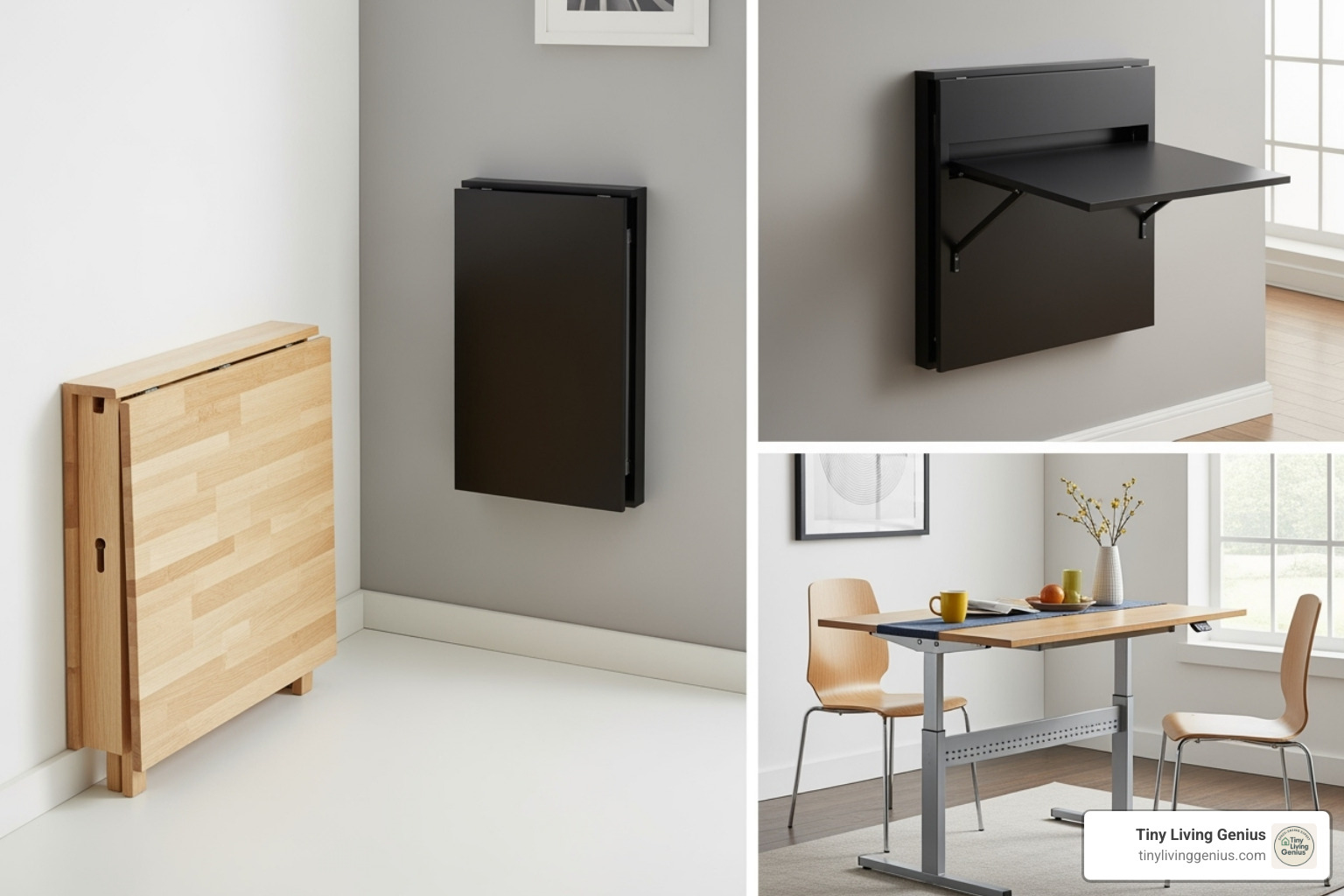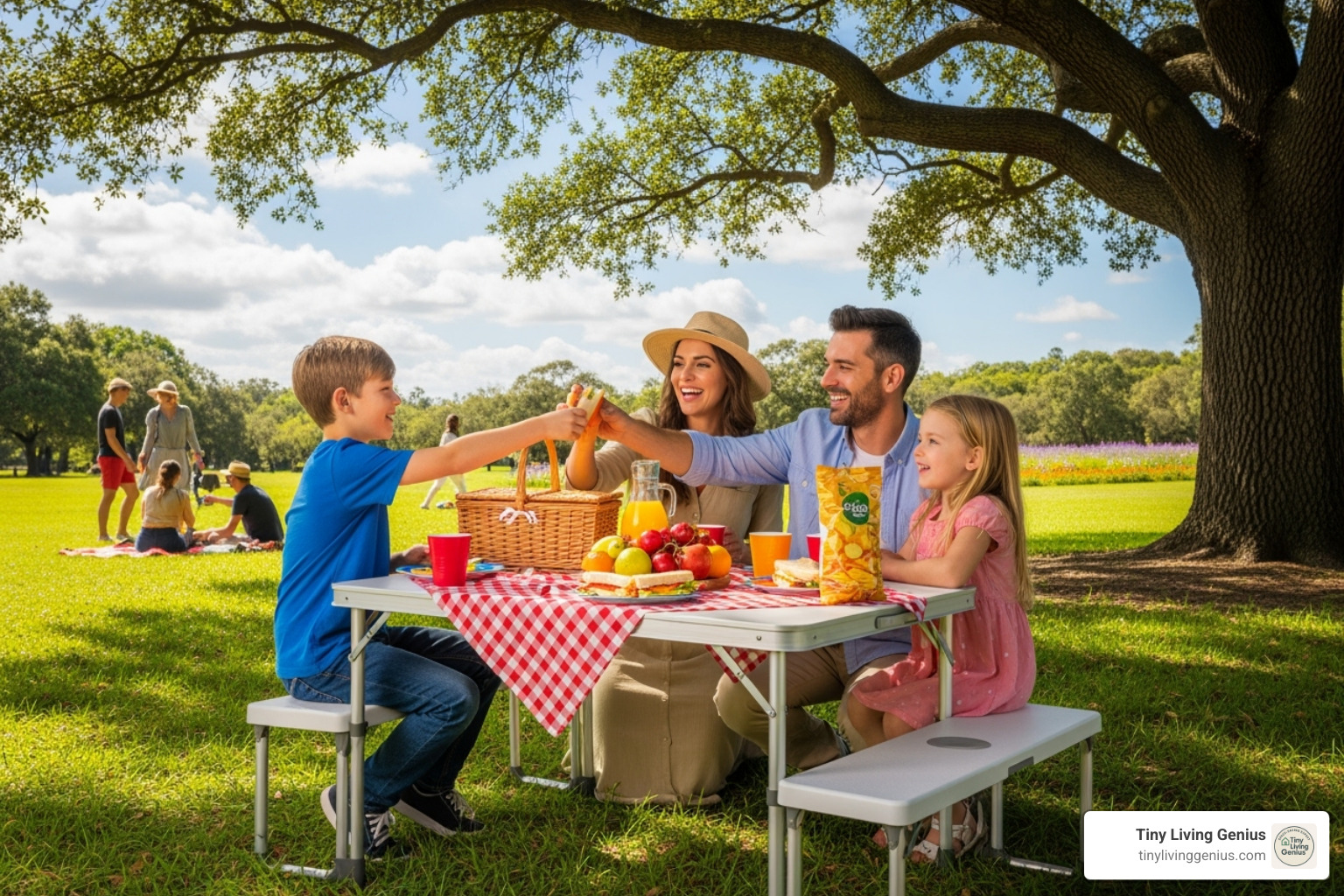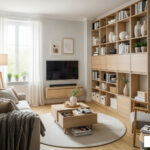Fold Out Table: Ultimate 2025 Smart Solutions
Why a Fold Out Table is Your Small Space Secret Weapon
A fold out table is a versatile, space-saving furniture piece that can be easily folded for storage and unfolded when needed. Here’s what you need to know:
Quick Facts:
- Best for: Small apartments, camping, events, temporary workspaces
- Common types: Fold-in-half, wall-mounted, drop-leaf, adjustable height
- Materials: Plastic (HDPE), wood, metal
- Price range: $40–$400+
- Key features: Portability, compact storage, multiple heights, locking mechanisms
Living in a small apartment means every piece of furniture needs to earn its keep. You can’t afford items that only do one job or take up precious square footage when not in use.
That’s where fold out tables shine. They transform from a full dining surface to virtually nothing in seconds. They serve as your desk during work hours, your dining table at dinner, and your hobby station on weekends. Then they tuck away into a closet or slip behind a door.
The research backs this up. Major retailers like Home Depot stock nearly 180 different folding table options, ranging from compact $45 models to premium $400+ versions. This variety exists because the demand is real—people need furniture that adapts to their space, not the other way around.
Whether you need a temporary workspace, a surface for entertaining guests, or a dining table that disappears when not needed, fold out tables deliver functionality without the footprint. They’re lightweight enough to move easily, sturdy enough for daily use, and affordable enough that you won’t break the bank.
I’m Ramy Saber, a Civil Engineer and founder of Tiny Living Genius, where I’ve spent years researching and testing space-saving solutions like the fold out table for compact living environments. My background in facility operations and project management gives me unique insight into what makes furniture both functional and durable for small-space dwellers.
Common fold out table vocab:
- sturdy folding chairs
Why Choose a Fold-Out Table? The Unbeatable Benefits
Let me tell you why I’m such a believer in fold out tables. After years of helping people make the most of their compact homes, I’ve seen how this one piece of furniture can completely transform how you live.
The biggest game-changer? Space-saving. And I’m not just talking about a few inches here and there. Picture this: you’re living in a 500-square-foot apartment. A permanent dining table eats up a quarter of your living area, making the whole place feel cramped. But with a fold out table, you have a full dining surface when you need it, then—boom—it folds away and suddenly you’ve got room to breathe, practice yoga, or let your kids play without bumping into furniture.
This is exactly the kind of smart thinking that makes compact living work. When every piece of furniture can disappear when not in use, you’re not just saving space—you’re creating flexibility in how you use your home.
Here’s where it gets even better: versatility. Your fold out table isn’t just a dining table. Monday through Friday, it’s your home office desk. Saturday morning, it’s a craft station for your DIY projects. Saturday night, it’s hosting game night with friends. Sunday afternoon, it’s your kid’s homework space. One table, endless possibilities.
This kind of multi-purpose thinking is at the heart of what we teach at Tiny Living Genius. Why own four different tables when one can do it all? For more ideas on furniture that works harder for you, check out The Ultimate Guide to Small Apartment Furniture: Smart Solutions for Tiny Living.
Then there’s portability. Most fold out tables are surprisingly lightweight and many come with built-in carry handles. Need to move your workspace to catch better natural light? Takes thirty seconds. Want to set up a buffet table on your balcony? Easy. Heading to the park for a family picnic? Grab and go. This kind of convenience means your furniture adapts to your life, not the other way around.
And let’s talk money. A quality fold out table won’t drain your bank account. You can find solid options like a 6-foot model for around $60 or an 8-footer for about $84. Compare that to traditional dining tables that can easily run several hundred dollars, and you’re getting serious functionality without the premium price tag. That’s what I call cost-effective living.
The bottom line? A fold out table gives you the freedom to use your space exactly how you want, when you want. It’s not just furniture—it’s a commitment to living smarter and more flexibly in your compact home.
Types of Fold-Out Tables: Finding Your Perfect Match
Shopping for a fold out table can feel a bit like dating—you need to find the right match for your lifestyle, space, and needs. The good news? There’s a perfect table out there for everyone, whether you’re living in a studio apartment or planning your next backyard barbecue.
Let me walk you through the main types of fold out table options so you can find your ideal companion.
Fold-in-Half & Centerfold Tables
Picture this: you grab a table by its built-in handle, fold it in half like a book, and tuck it away in your closet. That’s the beauty of a fold-in-half table. These are the workhorses of the folding table world, and for good reason.
The centerfold design means they collapse down the middle, changing from a full-sized surface into something slim enough to slide under a bed or stand in a narrow closet. The Lifetime 6 ft. Fold-in-Half Table is a perfect example—it offers plenty of workspace but stores away with minimal fuss.
These tables shine when you need ultimate portability. Moving them from your dining room to your garage to your friend’s party is genuinely effortless thanks to those handy carry handles. You’ll find them in both rectangular and round shapes, and they’re absolute champions for event use. Need to set up a long buffet table? Just line up a few rectangular models side by side.
Whether you’re hosting Thanksgiving dinner, setting up a craft station, or need a temporary desk for tax season, fold-in-half tables have your back. They’re the Swiss Army knife of compact storage solutions.
Wall-Mounted & Drop-Leaf Tables
If you’re working with seriously limited square footage, wall-mounted and drop-leaf tables are about to become your new best friends. These designs take maximum space-saving to a whole new level.
A wall-mounted fold out table literally disappears when you’re not using it. It attaches to your wall and folds flat against it, looking more like a shelf or decorative panel than a table. When dinner time rolls around, you simply fold it down and voilà—instant dining surface. They’re ideal for kitchens and small apartments where every inch matters.
Drop-leaf tables work a bit differently but achieve similar magic. They have hinged sections (called leaves) on one or both sides that drop down when you don’t need them. Want a cozy breakfast nook for two? Keep the leaves down. Hosting a dinner party? Raise them up for a full-sized table.
These designs work beautifully as a hideaway desk or dining solution in tight quarters. If you’re feeling creative and want something custom-built for your exact space, check out our DIY Foldable Desk Plans and Tutorials for step-by-step guidance.
Adjustable Height Tables
Some tables refuse to be pigeonholed into just one job, and adjustable height tables are the overachievers of the bunch. These ergonomic champions let you change the table height to match whatever activity you’re tackling.
Need a low table for your toddler’s art project? Lower the legs. Want a standing desk alternative for your afternoon work session? Raise them up. Planning a kids’ activity that requires just the right height? You’ve got options.
The Lifetime 4 ft. One Hand Adjustable Height Fold-in-Half Resin Table (available for $44.98) makes this adjustment incredibly easy—literally one-handed operation. This multi-purpose flexibility makes them fantastic for crafting, sewing, or any hobby where the right working height makes all the difference.
For more inspiration on how adjustable tables can transform your productivity and comfort, take a look at our Foldable Desk Ideas That Save Space and Boost Productivity.
Beyond these three main categories, you’ll also find specialized options like card tables (perfect for game nights), TV trays (individual surfaces for casual dining), banquet tables (large rectangular tables for events), and utility tables (heavy-duty workhorses for garages and workshops). Each brings something special to the table—literally—depending on what you need most.
A Buyer’s Guide to Your Next Fold Out Table
Shopping for a fold out table doesn’t have to feel overwhelming. Think of it as finding the perfect sidekick for your space – one that shows up when you need it and gracefully steps aside when you don’t. Let’s walk through what really matters when you’re making this choice.
The three big things to consider are what your table is made from, the features that will make your life easier, and what you can expect to pay. Get these right, and you’ll have a table that works hard for you without breaking your budget.
Decoding Materials: Plastic, Wood, and Metal
The material your fold out table is made from isn’t just about looks – it affects everything from how long it lasts to how much it weighs to what you’ll pay at checkout.
| Material Type | Durability | Price Range | Weight | Best Use |
|---|---|---|---|---|
| High-Density Polyethylene (HDPE) Plastic | Excellent; resistant to dents, scratches, and weather. | Budget-friendly – Mid | Light – Medium | Outdoor events, camping, kids’ activities, utility, temporary dining. |
| Wood (e.g., Solid Pine, MDF) | Good; varies with wood type; prone to scratches/moisture without finish. | Mid – Premium | Medium – Heavy | Formal events, home dining, aesthetic appeal, indoor use. |
| Metal (e.g., Aluminum, Steel Frame) | Very good; strong and stable; rust potential if not coated. | Mid – Premium | Light (Aluminum) – Heavy (Steel) | Commercial use, heavy-duty utility, modern aesthetics, outdoor (coated). |
Plastic tables, particularly those made from High-Density Polyethylene (HDPE), are the workhorses of the fold out table world. They shrug off dents and scratches like they’re nothing. Rain? No problem. Kids with markers? Wipes right off. Many feature powder-coated steel frames that add stability without adding much weight. The Lifetime 6 ft. Fold-in-Half Table in Almond, at just $59.98, is a perfect example – tough, light, and easy on the wallet. These tables often come with UV-resistant properties, making them ideal for that backyard barbecue or camping trip.
Wood tables bring warmth and character that plastic just can’t match. Whether you’re looking at affordable MDF with veneers or splurging on solid pine or oak, wood gives you that classic, homey feel. The HERCULES Series 7′ x 40″ Rectangular Solid Pine Folding Farm Table sits at the premium end at $417.98, but it delivers a sturdy, beautiful piece that looks right at home at a wedding or in your dining room. Just remember that wood needs a bit more TLC – keep it dry, wipe up spills quickly, and watch out for scratches.
Metal tables are the strength champions. Aluminum tops are lightweight and naturally rust-resistant, making them perfect for camping tables that you’ll be hauling around. Steel frames provide rock-solid stability and impressive weight capacity, though they’re heavier and need a protective coating if you plan to use them outdoors. Many plastic-topped tables use steel frames underneath to get the best of both worlds – lightweight top, strong base.
When you’re choosing, think about your main use case. Planning outdoor adventures? Weather-resistance moves to the top of your list. Want something for your dining room? Aesthetics might be your priority.
Key Features to Consider Before You Buy
Once you’ve settled on a material, it’s time to look at the details that separate a good fold out table from a great one.
Size and seating capacity should be your starting point. A 4-foot table comfortably seats four people, while an 8-foot model can handle eight to ten. But don’t just think about the unfolded size – where will you store it? Measure your closet or storage space before you fall in love with that 8-footer. Round tables work beautifully for intimate gatherings, while rectangular ones excel at banquet-style events.
Weight capacity matters more than you might think. A table groaning under Thanksgiving dinner needs serious strength compared to one holding a few drinks. Many tables specify their capacity in pounds – you’ll see ranges from 150 to 300 pounds for lighter-duty models, up to 450 pounds or more for heavy-duty options. Pay attention to whether that weight limit assumes even distribution or concentrated weight. Your utility table should handle more than your card table.
Portability becomes crucial if you’re moving your table around frequently. Look for lightweight designs, built-in carry handles, and folding mechanisms that don’t require a PhD to operate. Adjustable height models often fold down more compactly, which is a nice bonus.
Locking mechanisms are your safety net – literally. You want secure locks for both the legs and the tabletop (on fold-in-half designs). Auto-locking mechanisms are worth seeking out because they make setup foolproof and give you peace of mind. Nobody wants a table collapsing mid-meal.
Non-marring foot caps might seem like a small detail, but your floors will thank you. Those rubber or plastic caps on the feet prevent scratches and provide better grip, especially important if you’re using your table indoors.
Assembly requirements vary, though most fold out tables are gloriously simple – just unfold the legs and you’re done. Wall-mounted tables might ask more of you, potentially requiring tools and some DIY skills. If you value grab-and-go convenience, look for “no assembly required” in the product description.
If you’re specifically hunting for a desk solution, these considerations become even more important. We dive deeper into this in our guide on How to Choose the Perfect Foldable Desk for Small Spaces.
Understanding Price: What to Expect
Fold out table prices swing widely, from budget-friendly options around $40 to premium models pushing past $400. Some specialized tables climb even higher. What drives these differences?
Material costs play the biggest role. That HERCULES Series Solid Pine Folding Farm Table at $417.98 uses quality solid wood and substantial construction. Compare that to the Lifetime 4 ft. adjustable height table at $44.98, which uses HDPE plastic. Neither is better or worse – they’re built for different purposes and budgets. The thickness and quality of materials matter too, not just the type.
Size naturally affects price – larger tables use more materials and cost more to produce. An 8-foot table will run you more than a 4-foot one, assuming similar quality and features.
Features add up quickly. Adjustable height mechanisms involve more moving parts. Advanced locking systems cost more to manufacture. Integrated storage, waterproof coatings, and rust-proof finishes all bump up the price. But they also add real value if you need those capabilities.
Brand and design factor in too. Established brands known for quality often charge a bit more, but you’re paying for proven reliability. Unique designs or tables with special aesthetic appeal – like a stylish wooden drop-leaf – command premium prices.
Here’s the good news: you can find excellent value at every price point. The Lifetime 6 ft. Fold-in-Half Table delivers durability and functionality at $59.98. Outdoor enthusiasts can grab the CampMate Compact Foldable Table for R 550.00 (on sale from R 890.00) or the Infinity Fold-Away Camping Table for R 499.00 (originally R 599.00), both offering features custom to camping at competitive prices.
The smartest approach? Start with your primary needs, identify which features matter most for how you’ll actually use the table, and then find the best quality fold out table within your budget. Sometimes the $60 option is perfect. Sometimes it’s worth saving up for that $400 beauty. It all depends on what you need it to do.
Best Uses for Different Fold-Out Tables
The beauty of a fold out table lies in its chameleon-like ability to fit into virtually any setting. Whether you’re answering the call of the wild or making the most of a compact apartment, there’s a table design that’s perfect for the job. Let me walk you through how these versatile pieces shine in different scenarios.
For Outdoor Adventures: Camping & Picnics
If you’re the type who finds peace under open skies, a camping-ready fold out table is your best friend. The secret is in the design—these tables prioritize being lightweight and compact without sacrificing durability.
Look for tables with aluminum frames and weather-proof tops. The CampMate Compact Foldable Table is a perfect example, featuring UV-resistant 510G Textilene fabric and a powder-coated steel frame that laughs in the face of beach sand and backyard barbecues. Another solid choice is the Infinity Fold-Away Camping Table, which customers rate 4 out of 5 stars. It offers two height settings (50cm or 61.5cm) and a sturdy polypropylene top that pops up instantly when you need it.
The real magic happens in the setup. These tables unfold in seconds, meaning you spend less time wrestling with equipment and more time enjoying nature. Many come with thoughtful touches like built-in cup holders and rust-proof components. Whether you’re spreading out a picnic lunch or setting up camp for the weekend, the right table turns any outdoor spot into your temporary dining room.
For Entertaining: Parties & Events
There’s something wonderful about hosting friends and family, and a good fold out table makes it all possible without the stress. When you need to accommodate a crowd, banquet tables come to the rescue with their generous surface area and impressive weight capacity.
These larger rectangular or round tables are built to handle the chaos of entertaining. Picture a buffet spread laden with dishes, or a dessert table groaning under the weight of homemade treats—these tables hold it all without a wobble. The easy-to-clean surfaces, especially those made from HDPE plastic, are a lifesaver when inevitable spills happen.
Trestle tables offer a classic look that lifts any gathering while maintaining that crucial portability. You can find options like the 5-Foot Round Plastic Folding Table for intimate gatherings or the 6-Foot Plastic Folding Table for larger parties. The beauty is in the flexibility—set up multiple tables for a big celebration, then fold them away when the party’s over. Your living room transforms from event space back to everyday comfort in minutes.
For Small Spaces: The Ideal fold out table for Home & Work
This is where my heart truly lies, and where a fold out table becomes less of a furniture piece and more of a small-space superhero. In compact homes, furniture needs to pull double (or triple) duty, and these tables deliver.
Wall-mounted desks are particularly brilliant for tiny apartments. They fold flat against the wall when you’re done working, essentially vanishing from sight and freeing up precious floor space. Imagine a narrow hallway or studio apartment where every square inch counts—a wall-mounted table appears when you need it and disappears when you don’t.
Drop-leaf dining tables offer similar magic with a more traditional feel. The hinged sections fold down for everyday use, creating a slim console that barely registers. When friends come over for dinner, those leaves lift up to reveal a proper dining surface. It’s convertible furniture at its finest.
The real win is the multi-functional use these tables enable. Your morning coffee table becomes your afternoon workspace, then transforms into your evening craft station. A fold out table in a small home isn’t just furniture—it’s freedom to use your space however you need it in the moment. If you’re working with a particularly tight dining area, our guide on Dining Room Tables for Narrow Spaces offers even more targeted solutions.
The goal isn’t to cram more stuff into less space. It’s to choose furniture that bends to your life, not the other way around.
Care, Maintenance, and Where to Shop
Your fold out table is more than just a piece of furniture—it’s a versatile companion that adapts to your life. Whether it’s hosting dinner parties, serving as your weekend craft station, or changing into a temporary office, it deserves a bit of care to keep performing at its best. The good news? Maintaining these tables is refreshingly straightforward, and finding the right one has never been easier.
How to Maintain Your fold out table for Longevity
Taking care of your fold out table doesn’t require special skills or expensive products. A little attention goes a long way in extending its life and keeping it looking great. The key is understanding what your specific table needs based on its material.
If you have a plastic HDPE table, you’ve lucked out in the maintenance department. These workhorses are incredibly forgiving. When spills happen (and they will), simply wipe them up with a damp cloth and a bit of mild soap. For stubborn stains, a soft brush and gentle household cleaner will do the trick. Just steer clear of abrasive cleaners or scouring pads—they’ll scratch that smooth surface. After outdoor use, a quick wipe-down to remove dirt or pollen keeps everything fresh.
Wood tables ask for a bit more attention, but nothing overwhelming. The golden rule with wood is to wipe up moisture immediately. Use a damp cloth for cleaning, then dry the surface right away to prevent water damage. If your table has a finished surface, a periodic application of furniture polish keeps it glowing. For tables you use outdoors or those with minimal sealing, applying a weather-resistant sealant once a year protects against moisture and UV damage. Always avoid harsh chemicals that can strip away protective finishes.
For tables with metal frames—which most modern fold out tables have—maintenance is equally simple. Most frames come with powder-coated finishes that naturally resist rust. Clean them with mild soap and water, and you’re done. If you spot any chips or scratches in the coating, especially on tables used outdoors, touch them up with rust-inhibiting paint to prevent corrosion from taking hold.
Beyond cleaning different materials, proper storage makes all the difference. Always tuck your table away in a dry, covered area when it’s not in use. Extreme temperatures and moisture are the enemies of longevity. If you must store it outdoors, invest in a quality waterproof cover. Every few months, take a moment to check all the hardware—screws, bolts, and those crucial locking mechanisms. Tighten anything that’s come loose. This simple habit prevents wobbling and catches small issues before they become big problems.
Safety First: Setup and Usage Tips
We want your fold out table experience to be nothing but positive, which means talking about safety. These tables are designed to be user-friendly, but a few mindful practices ensure everything stays stable and secure.
The most important step happens before you put anything on your table: make sure all legs are fully extended and locked. This isn’t just a suggestion—it’s essential. Those auto-locking mechanisms many tables feature are your friends, but always give each leg a visual check and a gentle tug to confirm everything is secure.
Next, consider where you’re setting up. A fold out table needs stable, even ground to perform its best. Uneven surfaces create wobbling and instability, which nobody wants during dinner or a work session. If you’re outdoors on soft ground, place the legs on flat rocks or sturdy pads to prevent them from sinking.
When loading your table, think about even weight distribution. Piling everything on one corner or edge puts unnecessary stress on the structure. Spread items across the surface, and remember that weight capacity ratings typically refer to evenly distributed weight, not everything stacked in the center.
Watch those pinch points when folding or unfolding your table. Hinges and moving parts need to be treated with respect. Guide components smoothly and keep fingers clear of closing gaps. It only takes a second of attention to avoid a painful pinch.
Finally, always respect the manufacturer’s weight limits. These aren’t arbitrary numbers—they’re based on testing and engineering. Overloading your table invites structural failure and potential injury. If you’re hosting a feast or setting up heavy equipment, check those specs first.
Where to Find Your Table
Ready to welcome a fold out table into your life? You’re in luck—these practical pieces are everywhere, from neighborhood stores to online retailers with endless options.
Home improvement stores like The Home Depot are natural starting points. They stock an impressive range of utility and banquet-style tables, especially those durable plastic models that can handle just about anything. With nearly 180 folding table options available, you’ll find everything from compact 4-foot models to spacious 8-foot banquet tables. Find folding tables at The Home Depot to explore their selection in person or online.
Large retail chains like Walmart offer another convenient option, combining variety with accessibility. Their shelves hold everything from simple card tables for game night to robust utility tables for serious projects. The price range varies widely, making it easy to find something that fits your budget. Check out their collection at Browse folding furniture at Walmart.com.
For the widest possible selection, online marketplaces open up a world of possibilities. You’ll find options you might never see in stores, from ultra-compact camping tables to neat wood designs. Customer reviews become your guide, offering real-world insights into quality and performance.
If you’re after something specific—perhaps a beautiful solid pine folding farm table for special occasions or a unique wall-mounted design for your compact kitchen—specialty furniture websites cater to those particular needs. These retailers often carry premium options and can accommodate bulk orders if you’re furnishing a space or planning a large event.
When shopping, take your time comparing prices and reading product descriptions thoroughly. Customer reviews are gold—they reveal how tables perform in real homes, not just in product photos. At Tiny Living Genius, we believe the perfect fold out table is out there waiting for you, ready to make your small space work harder and smarter.
Frequently Asked Questions about Fold-Out Tables
We hear from readers every day who are curious about the ins and outs of fold out tables, especially those just starting their compact living journey. Let’s tackle some of the questions that pop up most often in our inbox.
What is the average weight a fold-out table can hold?
Here’s the thing about weight capacity: it’s all over the map, and for good reason. The amount of weight your fold out table can handle depends heavily on its size, what it’s made from, and how it’s built.
On the lighter end, you’ve got your small card tables and TV trays. These typically max out somewhere between 50 and 150 pounds. They’re perfect for a snack or a board game, but you wouldn’t want to pile them high with heavy equipment.
Most standard utility or banquet tables—the kind with plastic tops and steel frames—fall into the middle range. These workhorses can usually handle 150 to 300 pounds without breaking a sweat. They’re what you’d reach for when setting up a buffet or creating a temporary workspace.
Then there are the heavy-duty champions. These are your larger, reinforced tables, often with commercial-grade frames or solid wood tops. They can support 300 pounds or more, with some models exceeding 450 pounds. Our research into Home Depot’s product listings showed weight capacities ranging from “Less than 150” all the way up to “Greater than 450.”
Here’s a crucial detail most people miss: these weight ratings almost always refer to evenly distributed weight. If you pile everything in one spot or put a heavy object right in the center without support underneath, you’re putting much more strain on that specific area than the overall capacity suggests. Always check your specific fold out table‘s manufacturer specifications before loading it up. Better safe than sorry!
Can you use indoor fold-out tables outside?
This is one of those “it depends” situations that we get asked about constantly. The short answer is: check your materials first.
Plastic tables made from High-Density Polyethylene (HDPE) with powder-coated steel frames are generally your best bet for outdoor use. HDPE naturally resists moisture, shrugs off UV rays, and doesn’t mind temperature swings. Many tables from brands like Lifetime are specifically designed to go from your dining room to your backyard without missing a beat. These are outdoor-safe by design.
Wood tables, on the other hand, need more caution. Unless your wooden fold out table has been specifically treated or sealed for outdoor conditions, the elements will not be kind to it. Sun will fade and crack the finish. Rain will cause warping and eventually rot. If you absolutely must use a wood table outside, make sure it has a weather-resistant finish, and bring it back inside (or cover it thoroughly) as soon as you’re done.
Metal tables fall somewhere in between. If they’re rust-proof or have a durable powder-coated finish, they can handle outdoor duty just fine. But unfinished or poorly coated metal will rust faster than you can say “outdoor entertaining” when exposed to moisture.
Our rule of thumb at Tiny Living Genius: if the product description doesn’t explicitly say “outdoor safe” or “weather-resistant,” keep it indoors. Or if you do take it outside, make it a brief visit and bring it back in right away. A few hours in the sun for a picnic? Probably fine. Leaving it on the patio for weeks? Not so much.
How do I stop my fold-out table from wobbling?
A wobbly fold out table is more than just annoying—it’s a recipe for spilled drinks and potential accidents. The good news is that most wobbles have simple fixes.
Start with the obvious: make absolutely certain all the legs are fully extended and locked. This is the number one cause of wobbling we see. Those locking mechanisms—whether they’re push pins, lever locks, or auto-locks—need to be completely engaged. Give each leg a gentle tug to confirm it’s secure.
Next, check your ground. Even the sturdiest table will wobble on an uneven surface. Try moving to a different spot, or grab some shims (small pieces of wood or even folded cardboard work in a pinch) to slip under the shortest leg until everything’s level.
Over time, screws and bolts can work themselves loose. Take a moment to inspect where the legs attach to the tabletop and where leg sections connect to each other. A quick pass with a screwdriver or wrench to gently tighten loose fasteners often does the trick. Just be careful not to overtighten, especially on plastic components—you can crack them if you’re too aggressive.
While you’re inspecting, look for any damage. Bent legs, cracked plastic, or damaged hinges can all cause instability. If you find structural damage, it’s probably time to retire that table for safety reasons.
Some higher-end fold out tables come with adjustable foot caps that you can screw in or out to fine-tune the height. These leg levelers are fantastic for eliminating wobbles on floors that aren’t quite flat. If your table has them, use them!
Finally, make sure you’re not overloading the table. Exceeding its weight capacity can cause flexing and wobbling, even if the table doesn’t collapse outright. Distribute weight evenly across the surface rather than concentrating it in one spot.
Work through these steps methodically, and you’ll almost always solve the wobble. Your fold out table will be back to providing a stable, reliable surface for whatever you need.
Conclusion
So here we are at the end of our journey through the wonderful world of fold out tables. If there’s one thing I hope you take away from this guide, it’s that these ingenious pieces of furniture are so much more than just a backup plan for when guests arrive unexpectedly.
A fold out table represents a smarter way of living—especially when space is at a premium. It’s about having the flexibility to transform your environment on demand, whether that means creating a dining area that disappears after breakfast, setting up a craft station for a weekend project, or hosting a backyard barbecue with friends. The versatility these tables offer is genuinely life-changing for those of us navigating compact spaces.
We’ve covered a lot of ground together. You now understand the different types available, from those ultra-portable fold-in-half models perfect for camping trips to the space-maximizing wall-mounted designs that practically vanish when not in use. You’ve learned how to evaluate materials—whether HDPE plastic suits your outdoor adventures, solid wood matches your aesthetic vision, or metal frames provide the heavy-duty stability you need.
The buyer’s guide has equipped you with the knowledge to ask the right questions: What weight capacity do I actually need? Will this table wobble on my patio? How do I maintain it for years of reliable service? And perhaps most importantly, you now know where to shop, whether that’s browsing the extensive selection at The Home Depot, checking out budget-friendly options at Walmart, or exploring specialized retailers for that perfect piece.
The beauty of a fold out table is that it adapts to your life, not the other way around. Whether you’re investing $40 in a compact utility table or splurging on a $400+ premium wooden model, you’re making a choice that prioritizes functionality, convenience, and smart living.
At Tiny Living Genius, we believe that every piece of furniture in your home should earn its place by working harder and smarter. The fold out table does exactly that—it’s a simple, neat solution to making your space more livable, more flexible, and more you.
Now that you’re armed with all this knowledge, I’m confident you’ll find the perfect fold out table to fit your unique needs. And remember, this is just one piece of the puzzle when it comes to maximizing your living space. For more inspiration and practical advice on creating a home that works beautifully in every square inch, explore our complete guide to space-saving furniture. Your perfectly optimized, wonderfully functional compact space is waiting.

